All you need to know about your products!

| 3DNews Vendor Reference English Resource - All you need to know about your products! |
||||||
 |
||||||
|
|
||||||
ASUS M3N-HT Deluxe Mempipe (NVIDIA nForce 780a SLI)Author:Date: 09/09/2008
After quite a long while, the market has seen first motherboards based on new-generation NVIDIA chipsets for AMD processors. The most interesting products are motherboards built on the top-end nForce 780a chipset. The major trait of this chipset is that albeit comprising two chips, the second one is not a "south bridge"! The first and the major chip (780a SLI) includes the PCI Express bus controller, "south bridge" features, as well as the integrated graphic core GeForce 8400. The second chip is the well-known nForce 200 "bridge" which is aimed at implementation of additional PCI Express v2.0 lanes. Due to this "bridge", the chipset supports 35 PCI-E bus lanes, which allows setting up an SLI system with two (16+16) or three video cards (following the 8+8+8 scheme).  The focus in expansion options of the new chipset has somehow changed as compared to the nForce 590 SLI. In particular, the number of USB 2.0 ports has gone up from 10 to 12, with the number of Gigabit LAN controllers gone down from two to one. The remaining specifications remained unchanged: audio HD subsystem, five PCI slots, six SATA II links (supported is RAID 0,1,0+1,5), and one IDE link (with the option to plug in two devices). The pack of proprietary technologies has not changed (but for some minor improvements): MediaSheild, FirstPacket, support for the NVIDIA nTune. Now a few words on the integrated graphic core GeForce 8400.  To start with, at speed and functionality that is a rather powerful and interesting core which offers support for NVIDIA PureVideo HD, DirectX 10.0, HDMI, and HDCP. Besides, nForce 780a implements a really attractive Hybrid SLI technology which offers two important features: GeForce Boost, and HybridPower. The former is an analog to the Hybrid CrossFire and is aimed at value systems. Its idea is simple: if the user installs a value external video card (GeForce 8500 GT or GeForce 8400 GS) and enables the GeForce Boost, the computational resources of the external video card and the integrated video core are consolidated. Due to that, the user gets some speed gain in 3D applications. The latter feature (HybridPower) is a tribute to modern fashion for power-saving. Assume that the user has a high-end system with two or three video cards merged into an SLI array. That results in an unparalleled high speed in the most advanced games and 3D applications. But once the user quits Crysis and launches a web browser (or solitaire), all these powerful video cards put quite a high load uselessly, thus adding to the electricity bills. This situation is fixed by the HybridPower feature which seamlessly disables all the external video cards thus switching the load to the integrated video core. ASUS M3N-HT Deluxe Mempipe Specifications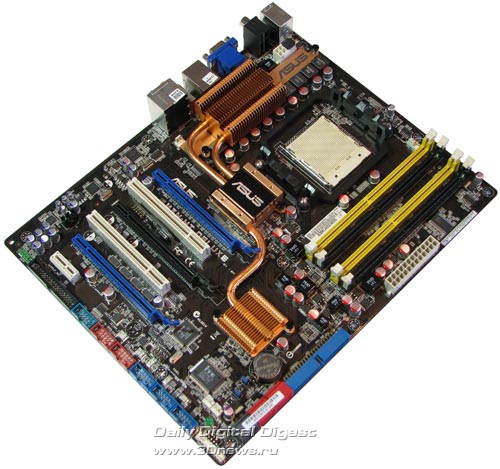
PackageThe board is packaged in a rather impressive box of stylish design:  Package bundleThe package bundle includes the following items:
The most interesting of the bundled items is the system for cooling memory modules, named MemPipe.  Most of the other items are standard. These are a user's manual, a DVD with drivers, utilities, and third-party software,  a kit of cables, a bracket for a FireWire and two USB ports. We also note a cap for the rear panel of the board in the package bundle (with noise-vibration-proof coating).  Among the non-standard items, there is an additional rotor fan and an HDMI=>DVI adapter.  We also note that the board offers all the required "bridges" to set up SLI arrays for two and three video cards. ASUS M3N-HT Deluxe Mempipe: Board Layout and FeaturesThere is nothing to complain about the PCB design, since the first PCI-Express video card does not block the DIMM latches. Even after installation of an additional Mempipe system, the user can replace memory modules without removing the video card.  Besides, we note that the main 24-pin connector is positioned on the bottom edge of the board, and the additional 8-pin one - on the right-hand end of the board. The backward compatibility to the PSY with a 4-pin cable has been preserved. For the convenience of plugging in a 4-pin cable, the "redundant" pins are closed with a plastic lid.  Near the DIMM slots, there is a 4-pin CPU_FAN connector to plug in a CPU cooler.  Besides it, there are three more 3-pin connectors: CHA_FAN1 and PWR_FAN1 - near the nForce 200 bridge, and CHA_FAN2 - near the PCI2 slot. Note that the M3N-HT Deluxe Mempipe not only determines the rotational speed of all the fans but also controls their speeds depending on the temperatures. On the "north bridge", there is a radiator linked to the PCI-E "bridge" and the impressive PWM radiator with heat pipes.  The board uses four DIMM slots. The maximum memory capacity makes 8 GB. We also note that DDR2-1066 is supported by AM2+ CPU only.  To enable the dual-channel mode, the memory modules should be inserted into the slots of the same color. Once voltage is applied to the board, the green LED in the bottom-left corner lights up. As regards the expansion options, the board uses three PCI Express x16 slots (all with holders) as well as one PCI Express x1 and two PCI slots.  Expansion optionsASUS M3N-HT Deluxe Mempipe supports 6 SerialATA-II links. The matching connectors are positioned near the nForce 200 "bridge" and are aimed in parallel to the board's plane.  Also on the board there is the additional RAID controller 88SE6111 made by Marvell. The same chip supports one more Serial ATA II link, with the respective port brought over to the rear panel. In the end, as many as nine hard disks can be plugged in to ASUS M3N-HT Deluxe Mempipe: seven - over the SerialATA II, with 2 via the ParallelATA.  Then, the board uses an Atheros Attansic F1 Gigabit LAN controller: 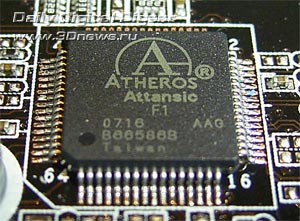 The board supports ten USB 2.0 ports, four of which are positioned on the rear panel, with 6 more plugged in via brackets (the board comes bundled with a bracket for two ports). Besides, the board offers support for the Firewire bus. For that, there is an additional FW3227 controller made by LSI. In the end, the board supports two IEEE1394 ports, with both of them plugged in with brackets (the board comes bundled with one bracket for one port).  The last thing to dwell on is the integrated High Definition Audio. The ADI 1988B chip is used as the codec which supports output for 8 channels.  The board's rear panel looks like this: 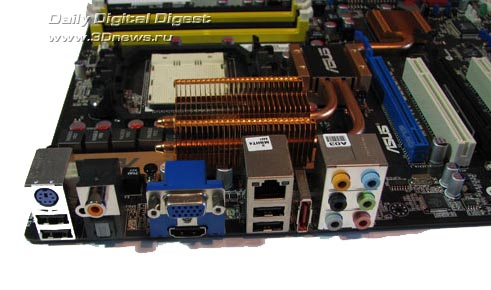 You can notice see a complete lack of LPT and COM ports. Instead of them, there are video outputs of the integrated graphic core (VGA and HDMI). We also note the optical and coaxial SP-DIF outputs as well as one SerialATA II port. Owners of the outdated hardware can make use of one COM port with a bracket. However, you would have to look for it at shops because it is missing in the package bundle.  Traditionally, a jumpers layout diagram:  Now on to the BIOS settings. BIOSThe BIOS of ASUS M3N-HT Deluxe Mempipe is built on the Award BIOS Phoenix version.  The extended pack of memory settings is in the "Extreme Tweaker/Overclocking/Memory Timing Settings" section:  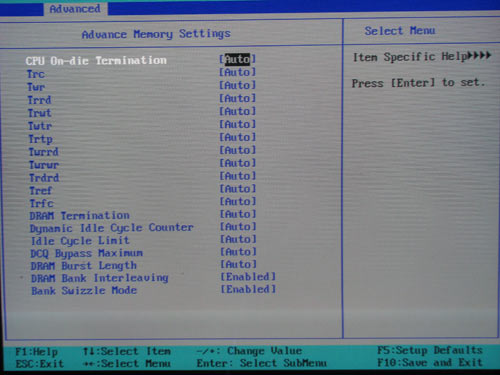   The parameter in charge of selecting the memory operating frequency is also over there: 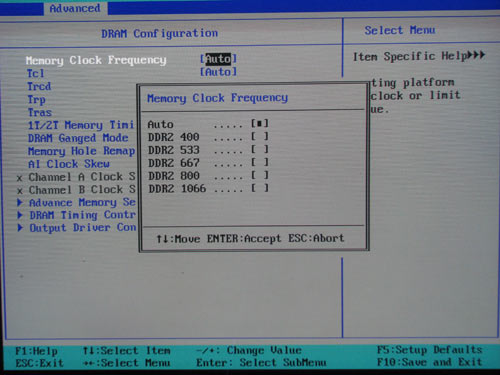 Now move on to the section to do with the system monitoring.  This section is really powerful. First, the board keeps track of the CPU's and system's current temperature and rotational speeds of the four fans. Besides, the user can control their speed with the Q-Fan feature.  It should be noted that the user gets access to all the technologies supported by modern AMD processors:  One of the ways to update the BIOS firmware is the EZ Flash utility integrated into the BIOS.  We also mention the OC Profile technology which allows saving all the BIOS settings into memory and loading them on demand.  A few more words on the settings of the integrated graphics core. In particular, the user can activate the Hybrid SLI feature,  as well as control the capacity of memory allocated to the needs of the integrated graphics: 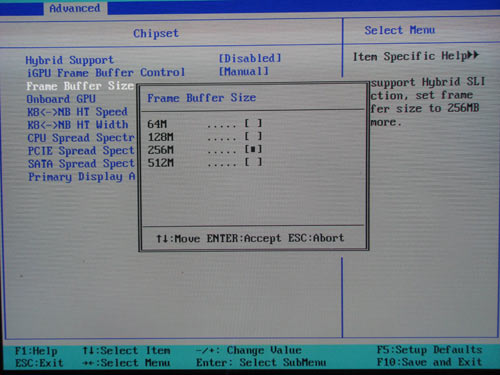 In conclusion, we note support for the Express Gate which is an undisputable advantage of any modern motherboard made by ASUS.   On M3N-HT Deluxe Mempipe, this technology has been implemented on the hardware level (like on all the previous high-end boards by ASUS).  Overclocking and stabilityThe power converter uses a 10-phase power scheme, in which there are three 270 mkF and ten 560 mkF capacitors.  As we already stated, the board offers quite a powerful cooling system which includes a massive radiator based on PWM power components. Besides, the user of M3N-HT Deluxe can "play a toy construction set". In particular, you can install an additional fan which is available in the package bundle. Besides, it is also possible to install the Mempipe system on top of the memory modules:  Now move on to examining the overclocking tools which are gathered in the "JumperFree" section.  First, ASUS M3N-HT Deluxe Mempipe allows adjusting the HTT speed within 200 to 600 MHz in 1 MHz increments.  The user can change the HyperTransport bus multiplier on the section between the NB and CPU:  This feature is of paramount importance for extreme overclocking. In particular, with the nominal value of this multiplier, we were able raising the HTT speed to merely 248 MHz. With the multiplier reduced to 7 (the nominal value for the HT multiplier in Phenom X3 is 9), we attained 276 MHz. Here are the remaining overclocking tools:
Now on to the practical overclocking. 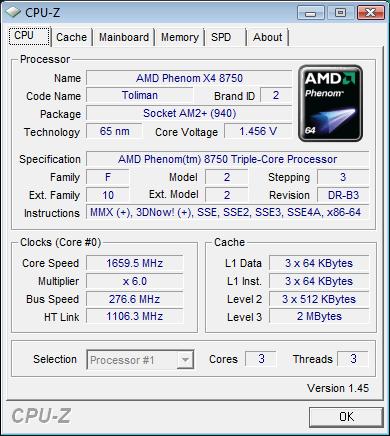 Unfortunately, we were unable to attain a stable operation at HTT speeds higher than 276 MHz. Selection of various BIOS firmware versions and replacement of memory modules did not bring any desired result: at that frequency, the board was running absolutely stably, but wouldn't start up at 277 MHz at all. The question is if such high frequencies are needed. The answer is certainly "yes", because to reveal the frequency capabilities of modern AMD processors a stable operation at HTT speeds at least 300 MHz is needed. In particular, our test processor AMD Phenom X3 8750 safely ran with the nominal multiplier (12).  Therefore, to attain the technology limits for processors with the much lower multiplier the system needs a stable operation at much higher HTT frequencies. By the way, we tested this motherboard with the CPU Athlon 64 3500+, and the system ran at HTT=300 MHz immediately after the first try (we did not run further experiments with overclocking single-core processors).  We still can't say why we failed to overclock the CPU Phenom. Perhaps further tests of other motherboards will prompt solution to this problem. As regards the integrated graphics core, the BIOS offers no features to overclock it. In theory, it would be possible to squeeze out a few more megahertz of the CPU clock speed through reducing the number of active CPU cores. This feature is supported by ASUS M3N-HT Deluxe Mempipe:  In conclusion, we note a feature which will help beginners overclock the system:  Performance testsNote that ASUS M3N-HT Deluxe Mempipe sets the nominal HTT speed to some overstatement:  During the performance tests, we compared ASUS M3N-HT Deluxe Mempipe versus ASUS P5Q Deluxe (Intel P45) (CPU Intel E6550 @ 2.33 GHz) and Jetway HA03 Ultra (AMD 790X). In our test setup, we used the following hardware:
Let's first take a look at the results of synthetic benchmarks.     Now on to the gaming benchmarks.         Tests of application software.    Video encoding (DivX, Xvid) was measured in seconds, i.e. the less the better.   Data compression (WinRAR) was measured in KB/sec, i.e. the more, the better.  Final WordsAbove all, ASUS M3N-HT Deluxe Mempipe is a good enough implementation of the frequency capability of the NVIDIA nForce 780a SLI chipset and can be regarded as a framework for the high-end system based on an AMD processor. Among the major advantages of the chipset, we note support for the 3-way SLI, as well as the integrated video core which due to the HybridSLI is able both saving power in the high-end system and accelerating the speed of 3D applications with an entry-level video card. However, we cannot avoid comparing this product versus a counterpart made by Intel. Even if we disregard the matter of performance (we'll come back to that in a review of the CPU Phenom), there is a great number of motherboards for Intel processors which offer more powerful expansion options at a comparable retail price (however, for the Intel system there are still no top-end chipsets with integrated graphics). Another point is the overclocking capability. To date, for the Intel platform there are many motherboards which allow "squeezing out" the most of processors. Unfortunately, ASUS M3N-HT Deluxe Mempipe can't do that with the current BIOS version. As regards the additional system for cooling the memory - Mempipe, we found no real advantage from using it. In our view, nominal heat spreaders for the overclocker memory do their job perfectly (especially with additional blowing), and modules without heat spreaders normally offer low overclocking capability and thus don't need any additional cooling. Conclusion
Pros:
Cons:
- Discuss the material in the conference
|
||||||||||||||||||||||||||||||||||||||||||||||||||||||||||||||||||||||||||||||||
|
|||||